For those contemplating the leap that is teaching English in South Korea, there's plenty of documentation out there to highlight the big picture draws of the country and the career. You know about the good money, the free accommodation, and the fact you can use South Korea as a launching pad into South East Asia - so here are the ten small pleasures that I've picked as reasons I love being in Korea again.
#10 - Pizza and Fried Chicken
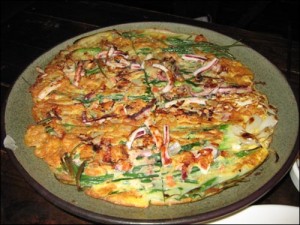
I hope you wanted corn with that...
I might not be a big fan of the Colonel's finest or its many, many imitators here in Korea - but if you like super greasy chicken, you're going to love being in Korea. Fried chicken joints seem to be almost every corner and a bucket of the stuff comes for about a third of the price of what you'd expect to pay back home. Pizza's the same story. While Pizza Hut and Dominoes are on par with what you'd expect to pay back home, you'll find plenty of cheap local chains offering good quality pizza for less than 10,000 won ($10 equivalent). The beauty of the local chains is that they'll usually treat their regulars to a little something extra - whether it be a small tub of cheese sauce or a large bottle of Coke to wash your greasy pizza down with.
A lot of these places deliver as well, and while only the bigger chains tend to have English speakers manning the phones, you're in luck if you can learn the basic Korean needed to order your favorite unhealthy snack and have it delivered right to your door.
A few words of warning though. Korean pizza makers seem to have more corn than they know what to do with. I've had cheese pizzas with corn kernels hidden underneath the cheese, and sometimes they seem genuinely confused when I request that there not be any corn on the pizza. You'll also find sweet potato in some form is a common pizza topping, so be careful when ordering if you're not a fan. As for chicken - they fry the entire bird, so don't scream when you find a deep fried chicken's foot wedged in between a wing and a breast.
#9 - Cheap Travel
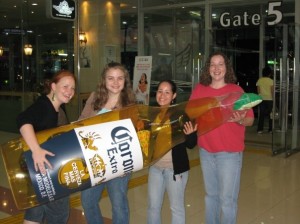
Silliness at the Gwangju Bus Terminal. Photo by Amber Rork.
I've mentioned the cheap travel perk in my entry on the Top 10 Reasons to Teach in South Korea, but it goes beyond the cheap buses and trains you can use to get around the peninsula. After a drunken night out you'll often find that you've missed the final city bus or subway home. Enter the humble Korean taxi. Sure, the drivers might try and bore you to death with their limited English or literally kill you with their erratic driving, but there's something to be loved about always being able to get home for an affordable price.
After paying $50 to get from one suburb of Sydney to another in twenty minutes, it's pretty refreshing to be able to get from one side of Korea's second largest city to the other at 5am for under $20 (equivalent). You'll occasionally get a driver who doesn't know where he's going or pretends not to, but by and large taxi drivers are going to be your best friend after a night of heavy drinking.
#8 - Coffee Shops
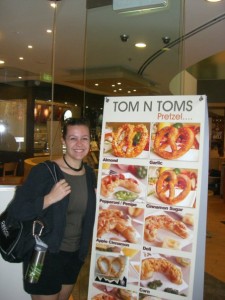
The delicious pretzels on offer at Tom & Toms. Taken in Sydney, strangely
Starbucks might be the most common of the many coffee chains in the country, but they're far from the only option for coffee lovers. There's Tom & Toms with their decadent stuffed pretzels, Kenya, Angel in Us, a Twosome Place, and a variety of others that offer a good variety of coffees as well as cakes and various other snacks. They also make for an ideal meeting point for nights out or adventures about the country, since their signs are always in English and usually stand out from the rest of the gaudily lit signs that line the streets.
#7 - Crazy Fast Internet
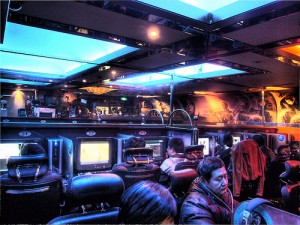
Just your typical Korean PC room. Photo by joopdorresteijn
Unlimited 100mbps cable internet for under $40 a month? Yeah, I don't really need to explain too much about this. I've downloaded countless songs, movies, TV shows, and games over the years in record time. Don't have a computer? There's a PC Bang (room) or four on every city block in the country. If you can stand the smoky air that seems to pervade these places, you'll find top of the line PCs and comfortable chairs as well as basic snacks, ramen, and drinks so that you don't even need to venture out into the harsh light of the day.
#6 - Festivals
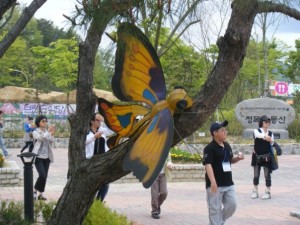
Once a year the Butterfly Festival turns Hampyeong into one of Korea's must see destinations
Korea is a country that loves a good festival. These range from the extravagant Lantern Festival in Jinju to the borderline orgy of Boryeong's Mud Festival. From Gwangju's quaint Kimchi Festival to Jindo's famous Moses Walk Festival. From the beautiful Hampyeong Butterfly Festival to the just plain weird such as the Slow Walking Festival. Barely a weekend passes in Korea without some kind of festival taking place somewhere, and if you're a sucker for foreign culture you'll never be short of something strange and interesting to do.
In 2011 I'm making it a mission of mine to get to as many of these festivals as I can, so be sure to check back here to find out more about them. You can already find two entries on here about the Mud Festival.
#5 - Foreigner Clubs
The foreigner community is a huge highlight of anybody's visit to Korea, and the various foreigner clubs are a huge part of this. Whether it's a local theater society, a book exchange club, a sporting team, or a hiking club - you're almost guaranteed to find like minded people to spend time with on your sober weekends. I myself have recently joined the Busan soccer club, the ultimate frisbee club, the hiking club, and the rock climbing club - and had been involved with the Gwangju community newspaper, the Gwangju theater society, and a Koreans & Foreigners dinner club in my last stints here. Facebook is a wealth of info regarding these clubs - and most cities will also have some kind of community website as well. Busan also has the pretty tremendous Busan Haps offering up info for the newcomers.
Foreigner magazines and newspapers offer up plenty of useful information as well. Gwangju's fantastic Gwangju news (edited by my good friend Dan Lister) is a wealth of info about the community, and entry #1 on this list offers up another choice piece of advice on how to make friends.
#4 - Noraebang
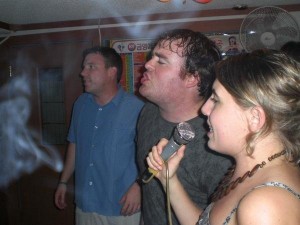
A much younger Chris singing his heart out in Busan in 2008
If you enjoy singing but are a bit too shy for karaoke or if you enjoy the hell out of karaoke but can't stand waiting for your turn to come around, noraebang is definitely for you. Take the fun of a good karaoke sesh, jam it into a tiny private room with couches and 'service' (free) snacks, add an extra echoey microphone, and put a bar full of cheap Korean beer and soju just outside the door and you've got the finish to pretty much any good night out in Korea.
It's not a truly epic night out in Korea if your night doesn't end with you emerging bleary eyed from a dimly lit noraebang into the dazzling early morning light. The song selection might be pretty much stock standard across the board as far as Western tracks go, but the required power ballads and cheesy love songs are there - and when you're slamming down somek (soju and beer mixed together) and stuffing dried squid and gim (sheets of lightly salted seaweed) into your mouth, it's really not about the tunes as much as the company.
#3 - Street Food
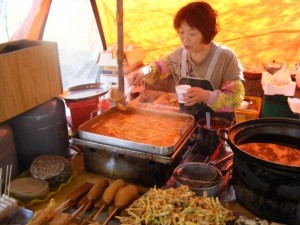
Twigim and tapbokki being served up in Gwangju
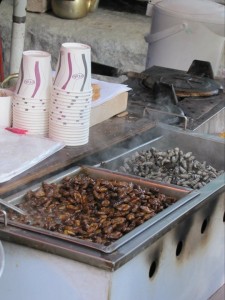
Bondeggi. As gross as it looks.
In Australia it's the humble kebab or meat pie and in the US it's fast food. In England it's a curry and in Canada it's... I don't know. Poutine? In Korea street food is big business, and you can't walk a hundred meters without seeing at least two or three little Mom & Pop businesses being run out of the back of a truck or from a tiny little cart. There's roast chestnuts and bondeggi (fried silkworm larvae that taste as bad as they smell), tapbokki (chewy rice cakes in a spicy sauce) and twigim (all manner of deep fried goodies dipped in soy sauce), toasted sandwiches and fruit on a stick, and a bunch of other weird and delightful things in between. Whether you're out on the piss and need some pizza in a cup (literally) or just hankering for a potato tornado (an entire potato spiraled, fried, and then put onto a stick with liberal ketchup) on a hot day, Korea is a world of delicious (and only occasionally disgusting) treats for you to discover.
#2 - Convenience Stores
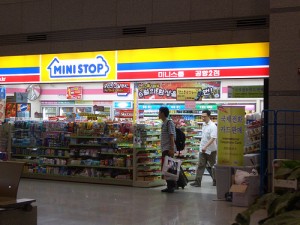
Ministop. They're everywhere.
I walk approximately five hundred meters on my way to school every day. On the way I pass three 7-11 stores and two G25s. There's also another G-25 on the opposite side of the road that I don't include in that count. Every one of these stores boasts a modest selection of groceries, a pretty extensive selection of drinks and snacks, an ATM that may or may not allow the use of foreign cards, a modest spirits selection, beer, cigarettes, various greasy snacks that are best avoided when sober, some basic wine options, and occasional offerings of kimbap (somewhat similar to a sushi roll) and pre-packaged sandwiches.
If it's midnight and you're in dire need of a bottle of water (Korean tap water isn't really drinkable) or a snack, you'll become quite friendly with your local convenience store operator. They're your go to spot for booze on a stinking hot July evening, make a pretty good place to drink during the warmer months (most have a small number of tables and chairs outside), and are probably amongst the first places you'll familiarize yourself when you stumble out of your apartment wide eyed and innocent on that first day in Korea.
#1 - Foreigner Bars
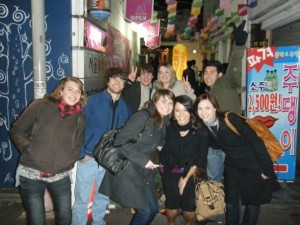
A few of my nearest and dearest head for Gwangju's German Bar in late 2008
I waxed lyrical about a few of my favorite haunts in Korea in my Top 10 Favorite Bars entry a while back, but it really needs to be emphasized that Korea is a drinker's heaven. That's not to say you can't have a good time here sober or that you won't make friends, but moreso than back home - alcohol isn't just a social lubricant, it's also the glue that generally binds the community together. I don't know whether it's sad to admit it or not - but I've been friends with some people for a few years now and never once spent any time with them sober. True story.
Any city worth its salt is going to have a few foreigner friendly bars. In Gwangju it's Speakeasy, Bubble Bar, German Bar, Soul Train, and Tequilaz. In Busan Thursday Party, Metal City, Eva's, Kino Eye, the Wolfhound, and Sharkies are just a few. Seoul has innumerable options including Geckos, the Wolfhound, Rocky Mountain Bar, and God knows how many more. Mokpo has P Bar and Ice Bar. I'd go on forever, but you get my point.
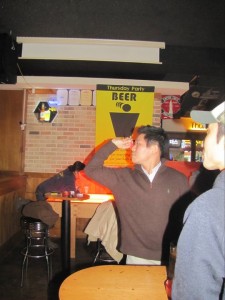
High stakes darts at one of many Thursday Party locations in Busan
Even in cities or areas of cities where there aren't any foreigner targeted bars, it only takes a few like minded people to turn a Korean establishment into a foreigner friendly one. Many a Fish & Grill (fantastic fruit soju smoothies) has been temporarily overtaken by foreigners, and I still have fond memories of a tiny little hole in the wall that myself and a bunch of other foreigners made our own early in my first year in Korea through sheer force of numbers.
In two weeks in Busan I've made more friends than I can count on one hand. Sure, the majority aren't 'tell my deepest secrets' kind of friends, but they're valued drinking buddies and I've even managed to spend sober time with one or two of them. And almost all of them were met at bars. One of my oldest friends in Korea is a guy I never got drunk with, but he's the exception rather than the rule. If you enjoy drinking - Korea's the place for you. If you don't, just be prepared to either spend time in bars sober or to have to work just that little bit harder to meet people. Entry #5 on this list covers that a little.
----------------
There's countless other reasons while you'll enjoy your year in (or visit to) Korea, but these are ten of the ones that keep me coming back for me. Did I miss any? Let me know.














 RSS Feed
RSS Feed


















Recent comments